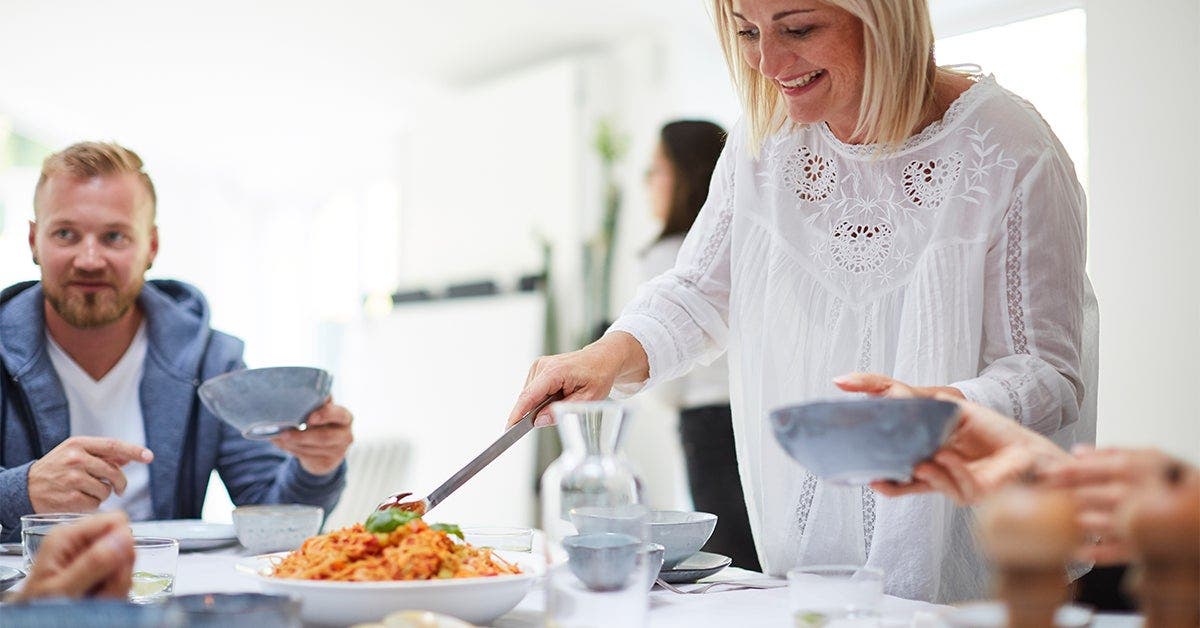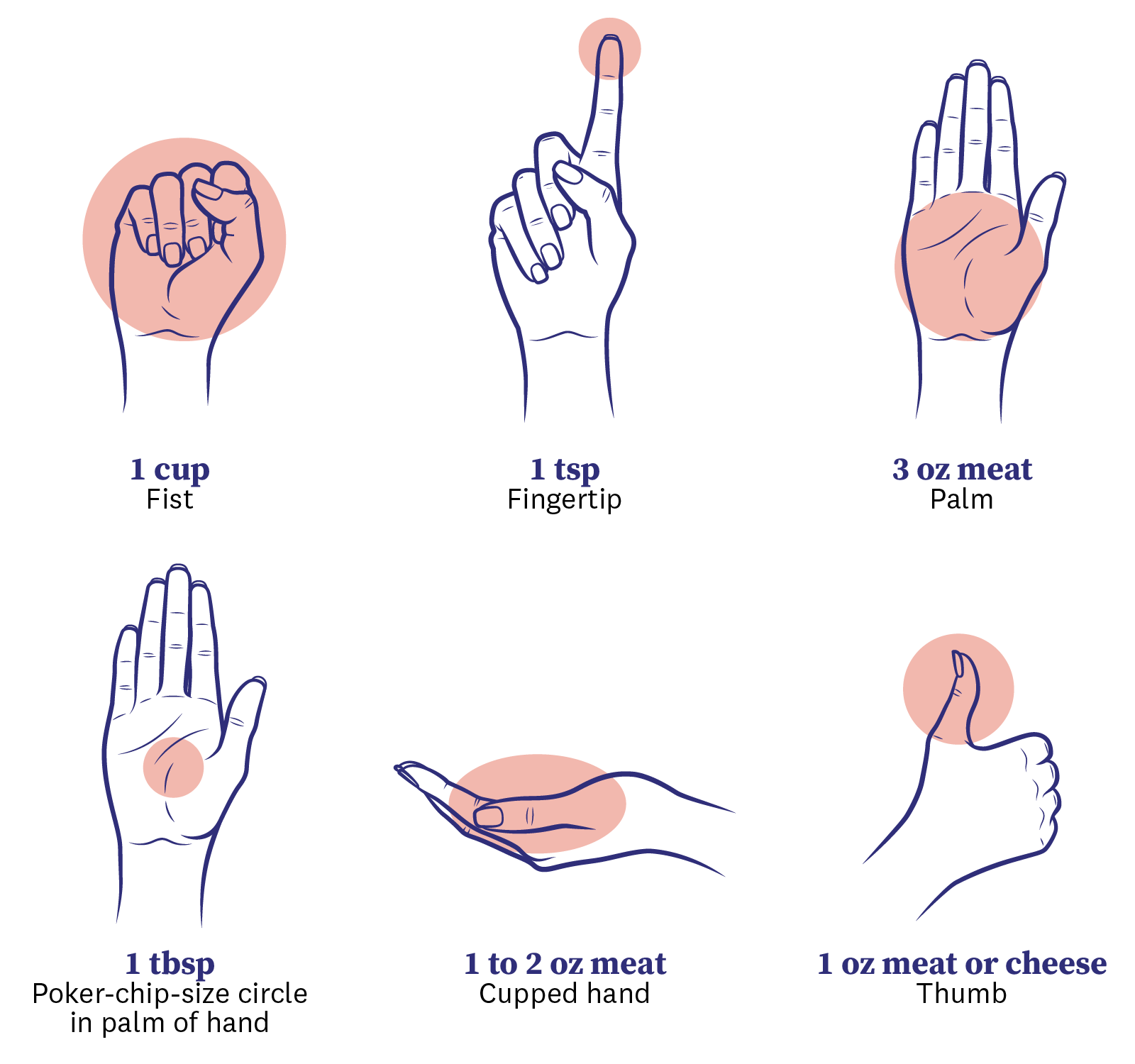How to pick the right portion sizes for you


The portion size that’s right for you depends on what you’re eating and how much you need to feel satisfied while staying within your Points™ Budget. Using tools like measuring cups and food scales makes it easy to dole out right-for-you portions when you’re at home. But toting those tools around when you’re out to dinner or at a party? That isn't going to cut it.
How to use your hands as a portion guide

- Your fist is about the same size as 1 cup of fruit or pasta.
- Your thumb (tip to base) is the size of 1 ounce of meat or cheese.
- Your palm (minus fingers) equals 3 ounces of meat, fish, or poultry.
- Your cupped hand equals 1 to 3 ounces of nuts or pretzels.
Of course, not all hands are the same size, so it wouldn't hurt to measure yours against some measuring spoons or cups, just so you know what you're working with.
Fruit portion guide
Although many fruits are on your ZeroPoint™ food list, and they provide a lot of health benefits, they aren't calorie-free. So, what should you aim for? The general rule is two servings of fruit a day.
What does a serving of fruit look like?
- 1 medium apple, banana, orange, or pear
- 2 small apricots, kiwi fruits, or plums
- 1 cup fresh fruit salad
What about fruits that have Points values?
Some fruit is more energy-dense (meaning, higher in calories) and easier to overeat than others. They're still nutritious, but you'll want to track them. For example:
- Coconut: 1/4 cup
- Dried fruit: 1/4 cup
Vegetables
Many vegetables are on your ZeroPoint food list—they’re a great way to bulk out your meals and help you feel fuller, longer. The USDA recommends 1 to 3 servings a day. A serving is about:
- Cooked non-starchy vegetables like broccoli, spinach, or carrots: 1 cup
- Leafy or raw vegetables: 2 cups
- Potatoes or other starchy vegetables, like corn: 1 medium (or 1 cup mashed)
What about vegetables that have Points values?
You'll want to take that into consideration when it comes to tracking. Unsure if a veggie has a Points value? Check the WW app or WW.ca
Meat
A serving of meat should take up about a quarter of your plate. Or, remember these handy comparisons:
- Red meat: Aim for a portion about the size of your palm
- Poultry: Go for the size of a computer mouse
- Pork: A deck of cards
Carbs
At least half the grains you eat in a day should be whole grains, according to the USDA.
- Rice: 1/2 cup, cooked
- Pasta: 1/2 cup, cooked
- Bread: 1 slice
- Cereal: 1 cup
10 tips for measuring and portioning
The best way to learn that amount is to do some measuring. Over time, you’ll train your brain to serve up the right amount automatically. This week try weighing and measuring the foods you eat frequently, using these steps:
1. Serve yourself
What’s your typical portion? Whatever it is, dish it out. Put the amount of pasta you would usually eat into your usual bowl or plate. Then...
2. Size it up
Measure or weigh that portion, using cups or a scale. Now you know how much you’re actually eating. (If you're a fan of spaghetti-style noodles, WW's handy tool takes the guesswork out of portioning your pasta before cooking.)
3. Track it
Use your WW app to find the Points value. (Hint: The barcode scanner is great for finding packaged foods.) How does this impact your Budget?
4. Decide what works
Does this portion work well with your Budget? Remember that you can bulk up any meal or snack with your ZeroPoint foods. For example, by using a little less pasta and adding lots of sautéed veggies instead, you can enjoy a delicious dinner that’s lower in Points.
5. Keep measuring cups and spoons handy in the kitchen
Measuring spoons are especially good for measuring out oil, salad dressing, and sugar. Short on drawer space?
6. Whether you're using a tablespoon or cup, it should be leveled off
The best measuring spoons and cups are ones that can be squared off for easy leveling.
7. Take your portion and then move away
You can always go back for seconds if you're still hungry.
8. Eat on smaller plates
Or bring your lunch in a bento box. (Stylish!)
9. Go for built-in portion control
Buy individual servings. It may cost you a bit more, but consider it a health savings.
10. Don't match your food to your plate
Researchers at Cornell University’s Food and Brand Lab found that people serve themselves 30% more food when the plate they’re using offers low contrast with the food in question—for example, serving white rice on a white plate. Try to choose plates that have a contrasting colour to the food you’re serving.
